warning PONTIAC VIBE 2005 Owner's Guide
[x] Cancel search | Manufacturer: PONTIAC, Model Year: 2005, Model line: VIBE, Model: PONTIAC VIBE 2005Pages: 374, PDF Size: 2.49 MB
Page 263 of 374

Brake Wear
The GT series has four-wheel disc brakes. All other
models have front disc brakes and rear drum brakes.
Disc brake pads have built-in wear indicators that make
a high-pitched warning sound when the brake pads
are worn and new pads are needed. The sound
may come and go or be heard all the time your vehicle
is moving, except when you are pushing on the
brake pedal �rmly.
{CAUTION:
The brake wear warning sound means that soon
your brakes will not work well. That could lead
to an accident. When you hear the brake wear
warning sound, have your vehicle serviced.Notice:Continuing to drive with worn-out brake
pads could result in costly brake repair.
Some driving conditions or climates may cause a brake
squeal when the brakes are �rst applied or lightly
applied. This does not mean something is wrong with
your brakes.
Properly torqued wheel nuts are necessary to help
prevent brake pulsation. When tires are rotated, inspect
brake pads for wear and evenly tighten wheel nuts in
the proper sequence to GM torque speci�cations.
If you have rear drum brakes, they do not have wear
indicators, but if you ever hear a rear brake rubbing
noise, have the rear brake linings inspected immediately.
Also, the rear brake drums should be removed and
inspected each time the tires are removed for rotation or
changing. When you have the front brake pads
replaced, have the rear brakes inspected, too.
Brake linings should always be replaced as complete
axle sets.
SeeBrake System Inspection on page 6-18.
5-41
Page 264 of 374
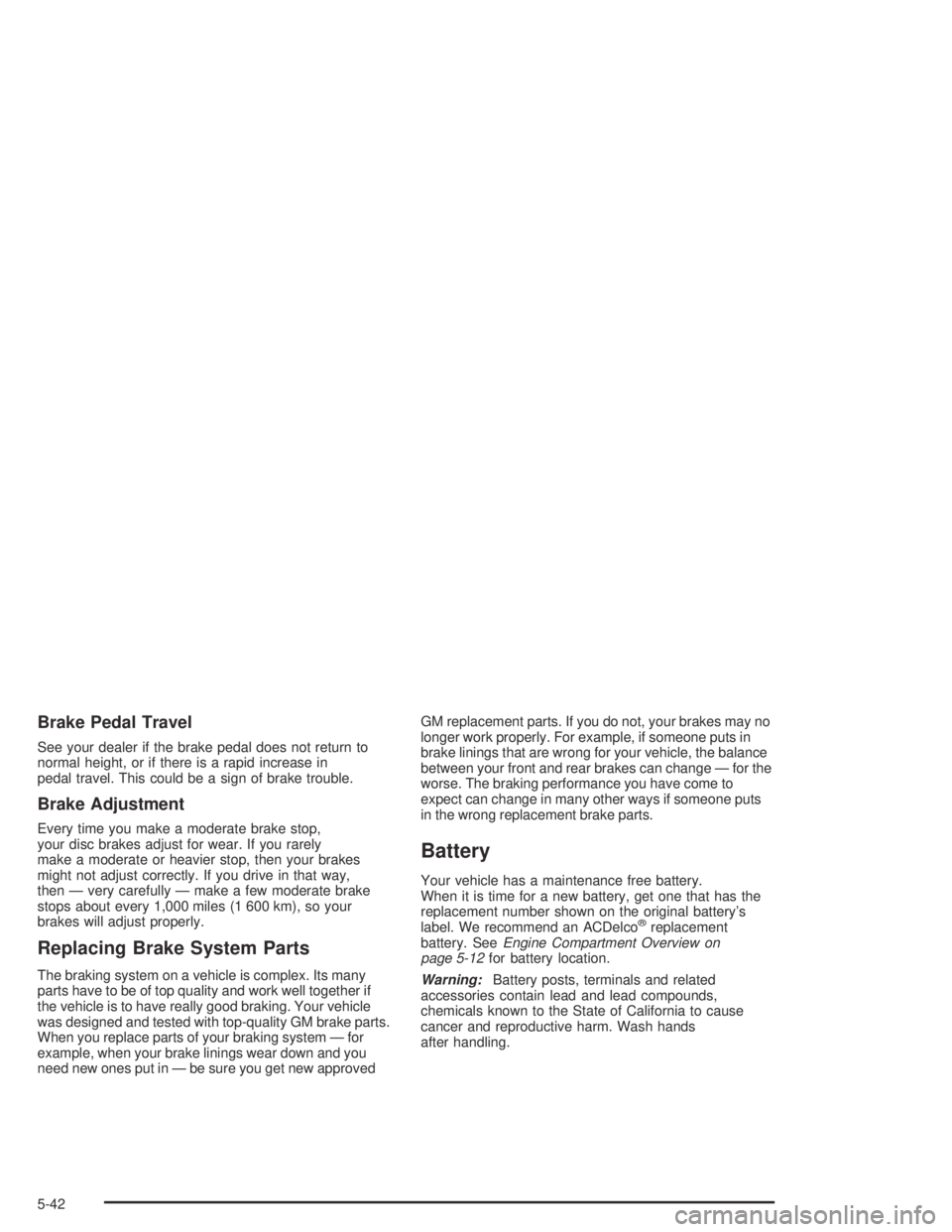
Brake Pedal Travel
See your dealer if the brake pedal does not return to
normal height, or if there is a rapid increase in
pedal travel. This could be a sign of brake trouble.
Brake Adjustment
Every time you make a moderate brake stop,
your disc brakes adjust for wear. If you rarely
make a moderate or heavier stop, then your brakes
might not adjust correctly. If you drive in that way,
then — very carefully — make a few moderate brake
stops about every 1,000 miles (1 600 km), so your
brakes will adjust properly.
Replacing Brake System Parts
The braking system on a vehicle is complex. Its many
parts have to be of top quality and work well together if
the vehicle is to have really good braking. Your vehicle
was designed and tested with top-quality GM brake parts.
When you replace parts of your braking system — for
example, when your brake linings wear down and you
need new ones put in — be sure you get new approvedGM replacement parts. If you do not, your brakes may no
longer work properly. For example, if someone puts in
brake linings that are wrong for your vehicle, the balance
between your front and rear brakes can change — for the
worse. The braking performance you have come to
expect can change in many other ways if someone puts
in the wrong replacement brake parts.
Battery
Your vehicle has a maintenance free battery.
When it is time for a new battery, get one that has the
replacement number shown on the original battery’s
label. We recommend an ACDelco
®replacement
battery. SeeEngine Compartment Overview on
page 5-12for battery location.
Warning:Battery posts, terminals and related
accessories contain lead and lead compounds,
chemicals known to the State of California to cause
cancer and reproductive harm. Wash hands
after handling.
5-42
Page 287 of 374
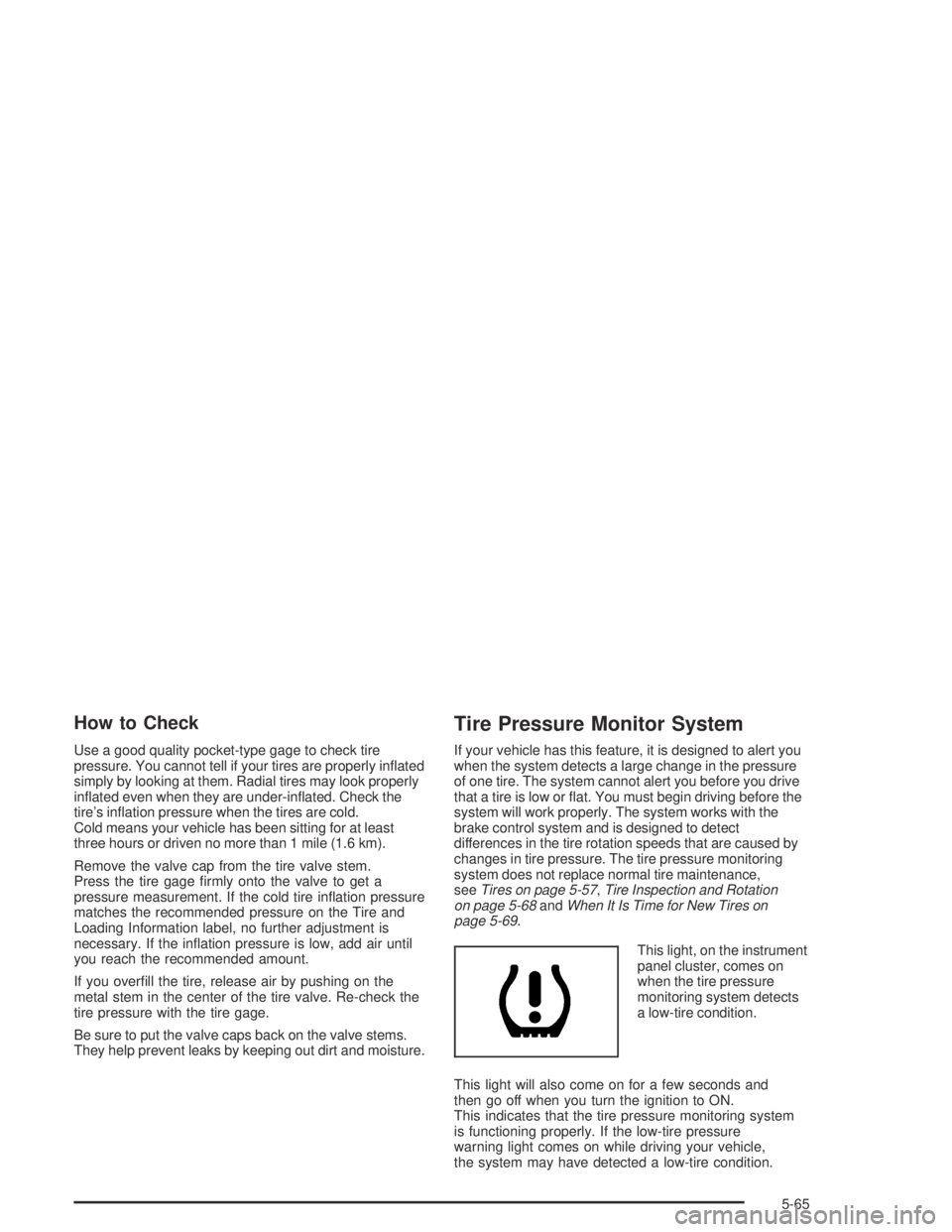
How to Check
Use a good quality pocket-type gage to check tire
pressure. You cannot tell if your tires are properly in�ated
simply by looking at them. Radial tires may look properly
in�ated even when they are under-in�ated. Check the
tire’s in�ation pressure when the tires are cold.
Cold means your vehicle has been sitting for at least
three hours or driven no more than 1 mile (1.6 km).
Remove the valve cap from the tire valve stem.
Press the tire gage �rmly onto the valve to get a
pressure measurement. If the cold tire in�ation pressure
matches the recommended pressure on the Tire and
Loading Information label, no further adjustment is
necessary. If the in�ation pressure is low, add air until
you reach the recommended amount.
If you over�ll the tire, release air by pushing on the
metal stem in the center of the tire valve. Re-check the
tire pressure with the tire gage.
Be sure to put the valve caps back on the valve stems.
They help prevent leaks by keeping out dirt and moisture.
Tire Pressure Monitor System
If your vehicle has this feature, it is designed to alert you
when the system detects a large change in the pressure
of one tire. The system cannot alert you before you drive
that a tire is low or �at. You must begin driving before the
system will work properly. The system works with the
brake control system and is designed to detect
differences in the tire rotation speeds that are caused by
changes in tire pressure. The tire pressure monitoring
system does not replace normal tire maintenance,
seeTires on page 5-57,Tire Inspection and Rotation
on page 5-68andWhen It Is Time for New Tires on
page 5-69.
This light, on the instrument
panel cluster, comes on
when the tire pressure
monitoring system detects
a low-tire condition.
This light will also come on for a few seconds and
then go off when you turn the ignition to ON.
This indicates that the tire pressure monitoring system
is functioning properly. If the low-tire pressure
warning light comes on while driving your vehicle,
the system may have detected a low-tire condition.
5-65
Page 288 of 374

You need to stop as soon as possible and check your
tires for damage. If a tire is �at, seeIf a Tire Goes
Flat on page 5-74andChanging a Flat Tire on
page 5-75. Also check the tire pressure in all four tires,
and set them to the speci�ed level shown on the tire
and loading label. SeeIn�ation - Tire Pressure on
page 5-64for additional information.
Note:The tire pressure monitoring system on
your vehicle will warn you when one of your tires
is signi�cantly under-in�ated and when some
combinations of your tires are signi�cantly
under-in�ated. However, there are other combinations
of signi�cantly under-in�ated tires for which your
tire pressure monitoring system may not warn you.
These other combinations are relatively common,
accounting for approximately half the instances in
which vehicles have signi�cantly under-in�ated tires.
For example, your system may not warn you when both
tires on the same side or on the same axle of your
vehicle are signi�cantly under-in�ated. It is particularly
important, therefore, for you to check the tire pressure in
all of your tires regularly and maintain proper pressure.
In order for the tire pressure monitoring system to
work properly you will need to reset (initialize) the tire
pressure monitoring system. Any time you check and/or
adjust a tire’s pressure, repair or replace a tire or
wheel or rotate the tires the tire pressure monitor system
needs to be reset.Do not reset (initialize) the system without �rst correcting
the cause of the low-tire condition. If the system is
reset when the tire pressures are incorrect, the system
will not function properly and may not alert you when
a tire is low.
To reset (initialize) the system:
1. Park the vehicle at a safe place and apply the
parking brake. Turn the engine off.
2. Turn the ignition to ON with the engine off.
3. If the low-tire pressure
warning light is on,
push the SET (reset)
button for a few
seconds. The low-tire
warning light should go
off. The reset button
is on the instrument
panel to the left of the
steering wheel.
5-66
Page 289 of 374
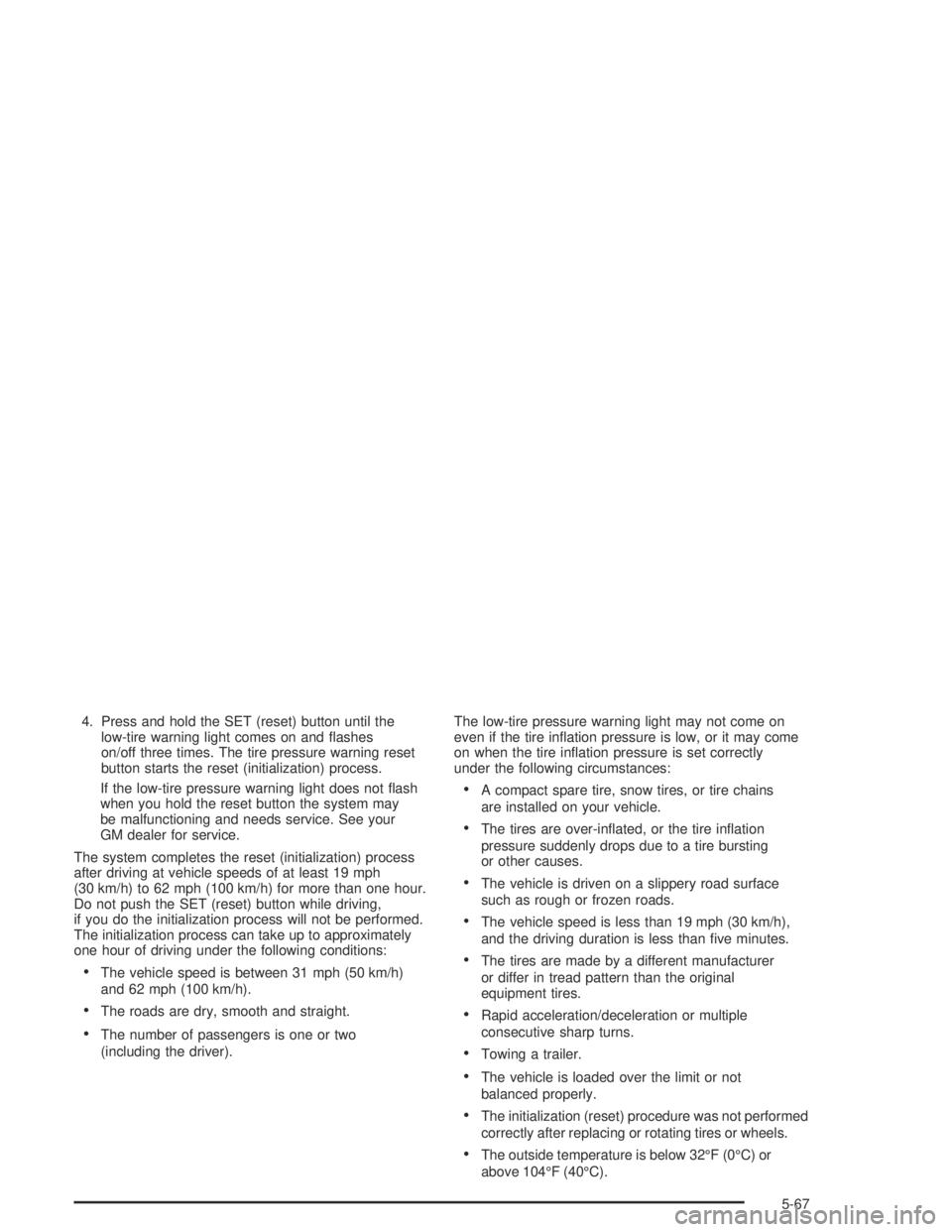
4. Press and hold the SET (reset) button until the
low-tire warning light comes on and �ashes
on/off three times. The tire pressure warning reset
button starts the reset (initialization) process.
If the low-tire pressure warning light does not �ash
when you hold the reset button the system may
be malfunctioning and needs service. See your
GM dealer for service.
The system completes the reset (initialization) process
after driving at vehicle speeds of at least 19 mph
(30 km/h) to 62 mph (100 km/h) for more than one hour.
Do not push the SET (reset) button while driving,
if you do the initialization process will not be performed.
The initialization process can take up to approximately
one hour of driving under the following conditions:
The vehicle speed is between 31 mph (50 km/h)
and 62 mph (100 km/h).
The roads are dry, smooth and straight.
The number of passengers is one or two
(including the driver).The low-tire pressure warning light may not come on
even if the tire in�ation pressure is low, or it may come
on when the tire in�ation pressure is set correctly
under the following circumstances:
A compact spare tire, snow tires, or tire chains
are installed on your vehicle.
The tires are over-in�ated, or the tire in�ation
pressure suddenly drops due to a tire bursting
or other causes.
The vehicle is driven on a slippery road surface
such as rough or frozen roads.
The vehicle speed is less than 19 mph (30 km/h),
and the driving duration is less than �ve minutes.
The tires are made by a different manufacturer
or differ in tread pattern than the original
equipment tires.
Rapid acceleration/deceleration or multiple
consecutive sharp turns.
Towing a trailer.
The vehicle is loaded over the limit or not
balanced properly.
The initialization (reset) procedure was not performed
correctly after replacing or rotating tires or wheels.
The outside temperature is below 32°F (0°C) or
above 104°F (40°C).
5-67
Page 293 of 374

While the tires available on General Motors passenger
cars and light trucks may vary with respect to these
grades, they must also conform to federal safety
requirements.
Treadwear
The treadwear grade is a comparative rating based on
the wear rate of the tire when tested under controlled
conditions on a speci�ed government test course.
For example, a tire graded 150 would wear one and
a half (1
1�2) times as well on the government course as
a tire graded 100. The relative performance of tires
depends upon the actual conditions of their use,
however, and may depart signi�cantly from the norm
due to variations in driving habits, service practices and
differences in road characteristics and climate.
Traction — AA, A, B, C
The traction grades, from highest to lowest, are AA, A,
B, and C. Those grades represent the tire’s ability
to stop on wet pavement as measured under controlled
conditions on speci�ed government test surfaces of
asphalt and concrete. A tire marked C may have poor
traction performance. Warning: The traction grade
assigned to this tire is based on straight-ahead braking
traction tests, and does not include acceleration,
cornering, hydroplaning, or peak traction characteristics.
Temperature — A, B, C
The temperature grades are A (the highest), B, and C,
representing the tire’s resistance to the generation
of heat and its ability to dissipate heat when tested
under controlled conditions on a speci�ed indoor
laboratory test wheel. Sustained high temperature can
cause the material of the tire to degenerate and
reduce tire life, and excessive temperature can lead to
sudden tire failure. The grade C corresponds to a
level of performance which all passenger car tires must
meet under the Federal Motor Vehicle Safety Standard
No. 109. Grades B and A represent higher levels of
performance on the laboratory test wheel than the
minimum required by law.
Warning: The temperature grade for this tire is
established for a tire that is properly in�ated and not
overloaded. Excessive speed, underin�ation, or
excessive loading, either separately or in combination,
can cause heat buildup and possible tire failure.
5-71
Page 297 of 374
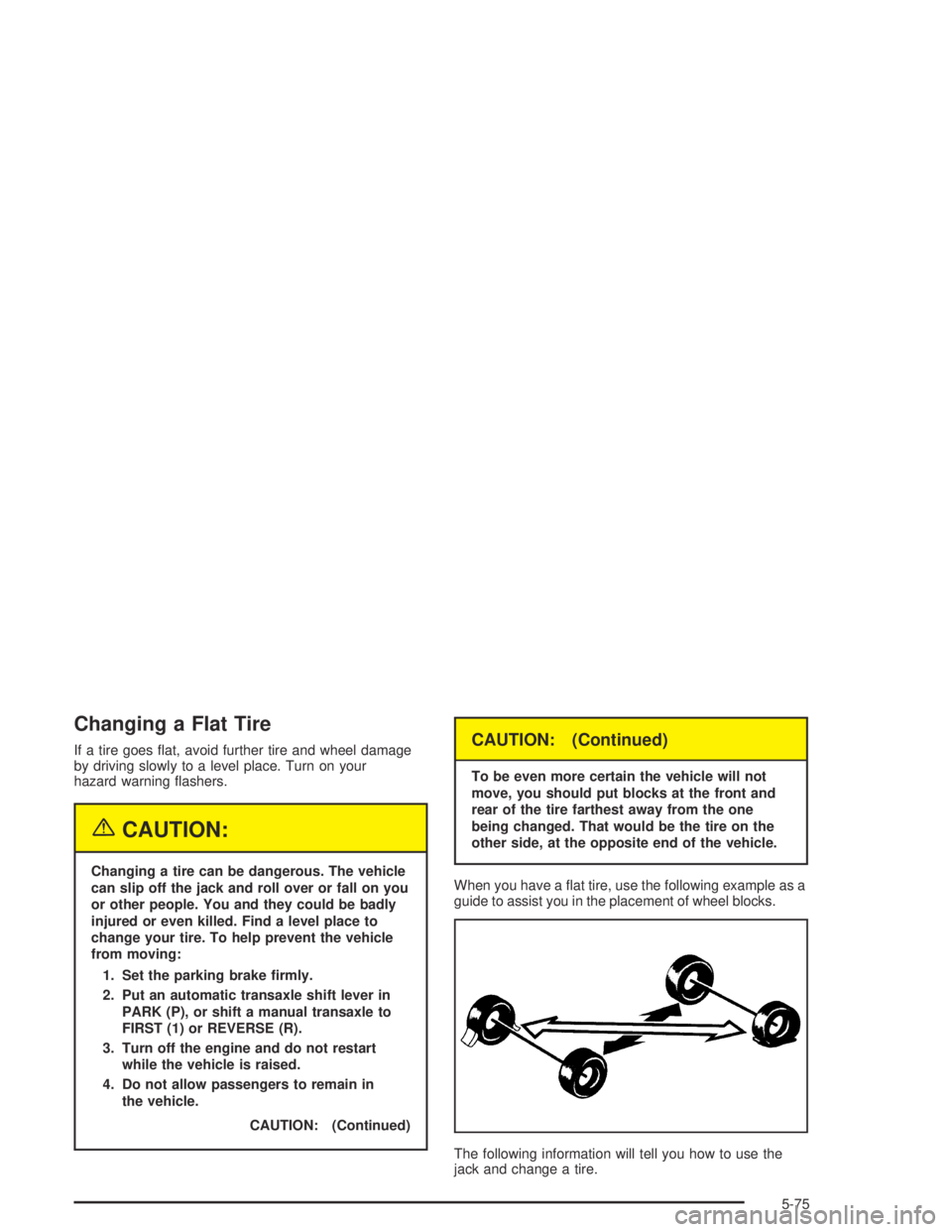
Changing a Flat Tire
If a tire goes �at, avoid further tire and wheel damage
by driving slowly to a level place. Turn on your
hazard warning �ashers.
{CAUTION:
Changing a tire can be dangerous. The vehicle
can slip off the jack and roll over or fall on you
or other people. You and they could be badly
injured or even killed. Find a level place to
change your tire. To help prevent the vehicle
from moving:
1. Set the parking brake �rmly.
2. Put an automatic transaxle shift lever in
PARK (P), or shift a manual transaxle to
FIRST (1) or REVERSE (R).
3. Turn off the engine and do not restart
while the vehicle is raised.
4. Do not allow passengers to remain in
the vehicle.
CAUTION: (Continued)
CAUTION: (Continued)
To be even more certain the vehicle will not
move, you should put blocks at the front and
rear of the tire farthest away from the one
being changed. That would be the tire on the
other side, at the opposite end of the vehicle.
When you have a �at tire, use the following example as a
guide to assist you in the placement of wheel blocks.
The following information will tell you how to use the
jack and change a tire.
5-75
Page 309 of 374
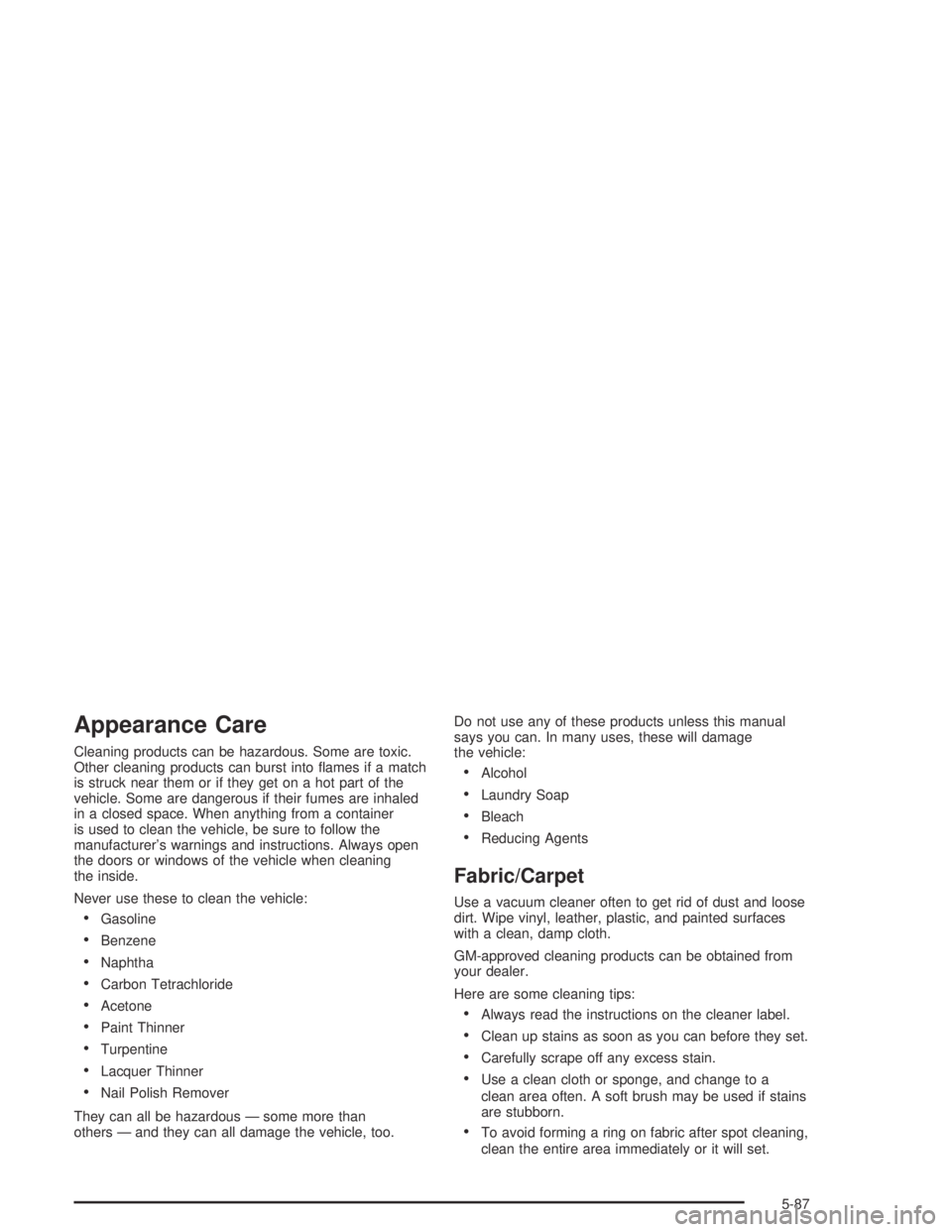
Appearance Care
Cleaning products can be hazardous. Some are toxic.
Other cleaning products can burst into �ames if a match
is struck near them or if they get on a hot part of the
vehicle. Some are dangerous if their fumes are inhaled
in a closed space. When anything from a container
is used to clean the vehicle, be sure to follow the
manufacturer’s warnings and instructions. Always open
the doors or windows of the vehicle when cleaning
the inside.
Never use these to clean the vehicle:
Gasoline
Benzene
Naphtha
Carbon Tetrachloride
Acetone
Paint Thinner
Turpentine
Lacquer Thinner
Nail Polish Remover
They can all be hazardous — some more than
others — and they can all damage the vehicle, too.Do not use any of these products unless this manual
says you can. In many uses, these will damage
the vehicle:
Alcohol
Laundry Soap
Bleach
Reducing Agents
Fabric/Carpet
Use a vacuum cleaner often to get rid of dust and loose
dirt. Wipe vinyl, leather, plastic, and painted surfaces
with a clean, damp cloth.
GM-approved cleaning products can be obtained from
your dealer.
Here are some cleaning tips:
Always read the instructions on the cleaner label.
Clean up stains as soon as you can before they set.
Carefully scrape off any excess stain.
Use a clean cloth or sponge, and change to a
clean area often. A soft brush may be used if stains
are stubborn.
To avoid forming a ring on fabric after spot cleaning,
clean the entire area immediately or it will set.
5-87
Page 361 of 374

A
Accessory Power Outlets.................................3-18
Adding Equipment to Your
Airbag-Equipped Vehicle...............................1-61
Additives, Fuel................................................. 5-6
Add-On Electrical Equipment............................5-95
Air Cleaner/Filter, Engine.................................5-21
Air Conditioning..............................................3-20
Airbag
Passenger Status Indicator...........................3-30
Readiness Light..........................................3-29
Airbag Sensing and Diagnostic Module (SDM)........ 7-9
Airbag System................................................1-46
Adding Equipment to Your Airbag-Equipped
Vehicle...................................................1-61
How Does an Airbag Restrain?......................1-53
Passenger Sensing System...........................1-56
Servicing Your Airbag-Equipped Vehicle..........1-60
What Makes an Airbag In�ate?......................1-53
What Will You See After an
Airbag In�ates?........................................1-54
When Should an Airbag In�ate?....................1-51
Where Are the Airbags?...............................1-49
All-Wheel Drive...............................................5-48
All-Wheel-Drive (AWD) System.........................4-11Antenna, Fixed Mast.......................................3-65
Antenna, XM™ Satellite Radio
Antenna System..........................................3-65
Anti-Lock Brake System (ABS)........................... 4-7
Anti-Lock Brake, System Warning Light..............3-33
Appearance Care............................................5-87
Aluminum Wheels........................................5-92
Care of Safety Belts....................................5-90
Chemical Paint Spotting...............................5-93
Cleaning Exterior Lamps/Lenses....................5-90
Fabric/Carpet..............................................5-87
Finish Care.................................................5-91
Finish Damage............................................5-93
Glass Surfaces............................................5-89
Instrument Panel.........................................5-89
Interior Plastic Components...........................5-89
Leather......................................................5-89
Sheet Metal Damage...................................5-93
Tires..........................................................5-92
Underbody Maintenance...............................5-93
Vehicle Care/Appearance Materials................5-94
Vinyl..........................................................5-89
Washing Your Vehicle...................................5-90
Weatherstrips..............................................5-90
Windshield, Backglass, and Wiper Blades.......5-91
Ashtrays........................................................3-19
1
Page 362 of 374

Audio System(s).............................................3-42
Care of Your CD Player...............................3-65
Care of Your CDs........................................3-64
Fixed Mast Antenna.....................................3-65
Navigation/Radio System..............................3-64
Radio with CD............................................3-43
Radio with Six-Disc CD................................3-53
Setting the Time..........................................3-42
Understanding Radio Reception.....................3-64
XM™ Satellite Radio Antenna System............3-65
Automatic Headlamp System............................3-15
Automatic Transaxle
Fluid..........................................................5-23
Operation...................................................2-22
B
Battery..........................................................5-42
Before Leaving on a Long Trip.........................4-23
Brake
Anti-Lock Brake System (ABS)........................ 4-7
Emergencies................................................ 4-9
Panic Assist................................................4-11
Parking......................................................2-28
System Inspection.......................................6-18
System Warning Light..................................3-32Brakes..........................................................5-39
Braking........................................................... 4-6
Braking in Emergencies..................................... 4-9
Break-In, New Vehicle.....................................2-17
Bulb Replacement...........................................5-49
Back-Up Lamps...........................................5-54
Center High-Mounted Stoplamp (CHMSL)........5-51
Halogen Bulbs............................................5-49
Headlamps, Front Turn Signal, and
Parking Lamps.........................................5-49
Replacement Bulbs......................................5-55
Taillamps, Turn Signal, and Stoplamps............5-53
Buying New Tires...........................................5-70
C
California Fuel.................................................. 5-6
Canadian Owners................................................ ii
Capacities and Speci�cations..........................5-100
Carbon Monoxide...................2-11, 2-32, 4-26, 4-40
Care of
Safety Belts................................................5-90
Your CD Player...........................................3-65
Your CDs ...................................................3-64
Cargo Cover..................................................2-39
2